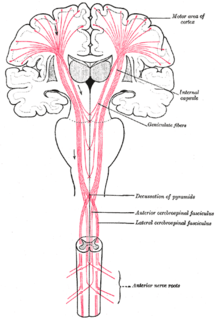Related Research Articles

The plantar reflex is a reflex elicited when the sole of the foot is stimulated with a blunt instrument. The reflex can take one of two forms. In healthy adults, the plantar reflex causes a downward response of the hallux (flexion). An upward response (extension) of the hallux is known as the Babinski response or Babinski sign, named after the neurologist Joseph Babinski. The presence of the Babinski sign can identify disease of the spinal cord and brain in adults, and also exists as a primitive reflex in infants.

Joseph Jules François Félix Babinski was a French-Polish professor of neurology. He is best known for his 1896 description of the Babinski sign, a pathological plantar reflex indicative of corticospinal tract damage.

An upper motor neuron lesion occurs in the neural pathway above the anterior horn cell of the spinal cord or motor nuclei of the cranial nerves. Conversely, a lower motor neuron lesion affects nerve fibers traveling from the anterior horn of the spinal cord or the cranial motor nuclei to the relevant muscle(s).

A reflex hammer is a medical instrument used by practitioners to test deep tendon reflexes. Testing for reflexes is an important part of the neurological physical examination in order to detect abnormalities in the central or peripheral nervous system.
Primitive reflexes are reflex actions originating in the central nervous system that are exhibited by normal infants, but not neurologically intact adults, in response to particular stimuli. These reflexes are suppressed by the development of the frontal lobes as a child transitions normally into child development. These primitive reflexes are also called infantile, infant or newborn reflexes.
Hoffmann's reflex is a neurological examination finding elicited by a reflex test which can help verify the presence or absence of issues arising from the corticospinal tract. It is named after neurologist Johann Hoffmann. Usually considered a pathological reflex in a clinical setting, the Hoffmann's reflex has also been used as a measure of spinal reflex processing (adaptation) in response to exercise training.
The Chaddock reflex is a diagnostic reflex similar to the Babinski reflex. Chaddock's sign is present when stroking of the lateral malleolus causes extension of the great toe, indicating damage to the corticospinal tract.
Bing's sign or Bing's reflex is a clinical sign in which pricking the dorsum of the foot or toe with a pin causes extension of the great toe. It is seen in patients with upper motor neuron lesion of the lower limbs. It is one of a number of Babinski-like responses.
Brissaud's reflex is a clinical sign in which stroking the sole of the foot elicits contraction of tensor fasciae latae. This can occur when there is no movement of the toes, and is part of the extensor plantar response or [Babinski's sign]

Charles Gilbert Chaddock (1861–1936) was an American neurologist remembered for describing the Chaddock reflex.
Stransky's sign is a clinical sign in which vigorous abduction followed by the sudden release of the little toe causes an extensor plantar reflex. It is found in patients with pyramidal tract lesions, and is one of a number of Babinski-like responses.
Cornell's sign is a clinical sign in which scratching along the inner side of the extensor hallucis longus tendon elicits an extensor plantar reflex. It is found in patients with pyramidal tract lesions, and is one of a number of Babinski-like responses.
Gonda's sign is a clinical sign in which flexing and then suddenly releasing the fourth toe elicits an extensor plantar reflex. It is found in patients with pyramidal tract lesions, and is one of a number of Babinski-like responses.
Gordon's sign is a clinical sign in which squeezing the calf muscle elicits an extensor plantar reflex. It is found in patients with pyramidal tract lesions, and is one of a number of Babinski-like responses.
Moniz sign is a clinical sign in which forceful passive plantar flexion of the ankle elicits an extensor plantar reflex. It is found in patients with pyramidal tract lesions, and is one of a number of Babinski-like responses.
Strümpell's sign is a clinical sign in which the patient's attempt to flex the knee against resistance elicits an extensor plantar reflex. It is found in patients with pyramidal tract lesions, and is one of a number of Babinski-like responses.
Throckmorton's reflex is a clinical sign in which pressure over the dorsal side of the metatarsophalangeal joint of the big toe elicits a plantar reflex. It is found in patients with pyramidal tract lesions, and is one of a number of Babinski-like responses.
Rossolimo's sign is a clinical sign in which percussion of the tips of the toes causes an exaggerated flexion of the toes. It is found in patients with pyramidal tract lesions, and is one of a number of Babinski-like responses.

The Madonna and Child with an Angel is a painting by the Italian Renaissance painter Sandro Botticelli, c. 1465–1467. It is housed in Spedale degli Innocenti of Florence.

Babinski–Nageotte syndrome is an alternating brainstem syndrome. It occurs when there is damage to the dorsolateral or posterior lateral medulla oblongata, likely syphilitic in origin. Hence it is also called the alternating medulla oblongata syndrome.
References
- ↑ Kumar SP, Ramasubramanian D (December 2000). "The Babinski sign--a reappraisal". Neurol India. 48 (4): 314–8. PMID 11146592 . Retrieved 2009-04-13.